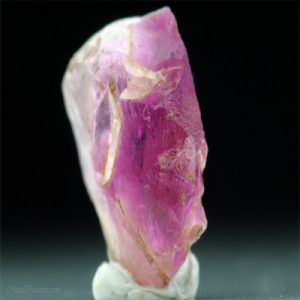Poudretteite
Poudretteite is one of the rarest gems on Earth. The chemical formula of Poudretteite is KNa2B3SI12O30 (Potassium Sodium Boron Silicate) and its molecular weight is 912.90 gm. It was discovered in the Poudrette quarry, Mont Sainte-Hilaire, Quebec, Canada in 1987 and more recently in 2000 in the Mogok Valley in upper Myanmar (Burma). Until the recent find in Mogok, only very tiny crystals were found at Mont Sainte-Hilaire, not large enough to be faceted. Poudretteite has a specific gravity of 2.51 (g/cm3) and the refractive index of 1.516 – 1.532 Uniaxial ( + ). The first Mogok find initially resulted in less than a dozen faceted gems. A pale pink and colorless crystal was found that was originally identified as Scapolite but was later identified as a new discovery of Poudretteite. Poudretteite is a member of the Osumilite (Milarite) Group of minerals that includes Milarite, Poudretteite, Sogdianite and Sugilite. Poudretteite is found as colorless and pale pink to pink.
| Chemical Formula: | KNa2B3SI12O30 |
| Potassium Sodium Boron Silicate | |
| Molecular Weight: | 912.90 gm |
| Composition: | Potassium | 4.28 % | K | 5.16 % | K2O |
| Sodium | 5.04 % | Na | 6.79 % | Na2O | |
| Silicon | 36.92 % | Si | 78.98 % | SiO2 | |
| Boron | 1.18 % | B | 3.81 % | B2O3 | |
| Oxygen | 52.58 % | O | |||
| 100.00 % | 94.74 % | = TOTAL OXIDE |
| Crystallography: | Hexagonal – Dihexagonal Dipyramidal |
| Crystal Habit: | As roughly equant, barrel-shaped prismatic crystals, deeply etched, to 5 mm. |
| Twinning: | None |
| Cleavage: | None observed |
| Fracture: | Splintery to Conchoidal |
| Tenacity: | Brittle |
| Moh’s Hardness: | 5.0 – 6.0 |
| Density: | 2.51 (g/cm3) |
| Luminescence: | None |
| Radioactivity: | Barely Detectable, GRapi = 61.48 (Gamma Ray American Petroleum Institute Units) |
| Color: | Colorless to pale pink |
| Transparency: | Transparent |
| Luster: | Vitreous |
| Refractive Index: | 1.516 – 1.532 Uniaxial ( + ) |
| Birefringence: | 0.0160 – 0.0210 |
| Dispersion: | n/a |
| Pleochroism: | n/a |


